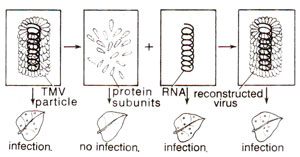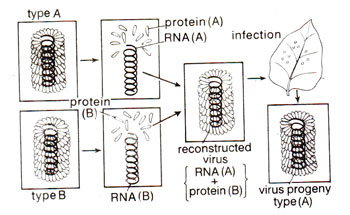Experiments with tobacco mosaic virus (TMV)
With the help of transformation experiment and bacteriophage infection discussed above, it was shown that DNA is the genetic material. The first evidence that RNA also has the capacity to carry genetic information came from experiments conducted with tobacco mosaic virus (TMV). This virus does not contain any DNA, and is composed of RNA (6%) surrounded by a hollow cylinder of protein subunits. The experiments conducted by H. Fraenkel-Conrat in California showing that RNA is the genetic material in this virus will be briefly discussed in this section.
Techniques were first developed for separating TMV particles into RNA and proteins. Later by using RNA and proteins separately in tests for infectivity, it could be shown that RNA alone was able to cause infection. Such a property was not found in the protein fraction (Fig. 25.5). It was also possible to synthesize chimeric virus particles using RNA from one strain and protein from another strain. Such chimeras had serological properties of those strains from which protein was derived, but in other properties, it resembled the other strain from which RNA was used.

 In one experiment, two viruses used were tobacco mosaic virus (TMV) and Holmes rib-grass virus (HRV). The latter was isolated from Plantago lanceolata and therefore, is also known as Plantago strain. Proteins of these two viruses differ in having different frequencies and sequences of amino acids. Also these viruses give different symptoms. On leaves of a particular variety of tobacco, while TMV produces mottling of leaves, HRV produces distinct ring patterns. Reciprocal chimeras using RNA of one strain and protein of the other strain could be obtained. It was found that when these chimeras were used for infection, the progeny had proteins which corresponded to the virus from which RNA of the infecting virus particles was derived. This proved that specificity of virus proteins was determined by RNA alone and that proteins carried no information. Results of these experiments are diagrammatically represented in Figure 25.6.
In one experiment, two viruses used were tobacco mosaic virus (TMV) and Holmes rib-grass virus (HRV). The latter was isolated from Plantago lanceolata and therefore, is also known as Plantago strain. Proteins of these two viruses differ in having different frequencies and sequences of amino acids. Also these viruses give different symptoms. On leaves of a particular variety of tobacco, while TMV produces mottling of leaves, HRV produces distinct ring patterns. Reciprocal chimeras using RNA of one strain and protein of the other strain could be obtained. It was found that when these chimeras were used for infection, the progeny had proteins which corresponded to the virus from which RNA of the infecting virus particles was derived. This proved that specificity of virus proteins was determined by RNA alone and that proteins carried no information. Results of these experiments are diagrammatically represented in Figure 25.6.
Subsequently, after the demonstration of genetic nature of RNA in TMV, RNA was found in a number of bacteriophages. Therefore, it may be concluded that nucleic acids in general, RNA as well as DNA, carry genetic information. However, DNA perhaps always functions as genetic material. But RNA in majority of cases is non-genetic; only in specific systems where DNA is absent, it functions as genetic material. In recent years, RNA has been shown to function as enzymes (ribozymes) also. This aspect of RNA led to award of Nobel Prize in chemistry in 1989 (T. Cech and S. Altman) and will be discussed in more detail in Expression of Gene : Protein Synthesis 3. RNA Processing (RNA Splicing, RNA Editing and Ribozymes).
Techniques were first developed for separating TMV particles into RNA and proteins. Later by using RNA and proteins separately in tests for infectivity, it could be shown that RNA alone was able to cause infection. Such a property was not found in the protein fraction (Fig. 25.5). It was also possible to synthesize chimeric virus particles using RNA from one strain and protein from another strain. Such chimeras had serological properties of those strains from which protein was derived, but in other properties, it resembled the other strain from which RNA was used.

Fig. 25.5. Experiment of Fraenkel-Conrat on TMV showing that RNA and not the protein can cause infection.

Fig. 25.6. Reconstruction of virus, showing that reconstructed virus gives progeny which resembles the virus from which RNA was derived.




